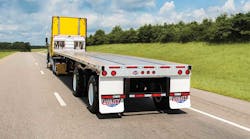Utility Trailer Manufacturing’s Craig Bennett said his company had a strong 2016 and expects another one in 2017.
Addressing a meeting of trucking industry trade press editors January 25, Bennett said he is “fairly optimistic about 2017. It will be down a little, but not too bad.”
This past year was Utility’s second-best in its 103-year history, down only slightly from 2015.
“We built 46,000 trailers last year,” Bennett said. “It was our second-biggest year ever,” he said.
But production numbers are only part of the story. Last year saw a major uptick in the number of trailers that are more time-consuming to build, a change that made a big difference for Utility’s bottom line.
“The trailer manufacturing industry uses production as its yardstick,” Bennet said, “but we have labor hours to sell, too. And we are selling more trailers with high labor content—food service trailers, for example, and dry vans with double decking.
“With the driver shortage, users need to get greater payload into each trailer. To do that, customers are asking us to install more accessories and to modify trailers in order to make them and the driver as productive as possible.
The result—more work, despite fewer trailers.
“The industry keeps score in units,” Bennett said. “We keep score in hours. A typical reefer trailer may take 120-130 hours to build. A typical food service trailer may take 250-300 hours to build. We sold fewer units last year but more hours. Our revenues are up, even though our units are down.”
Utility believes that the shortage of drivers is making trailer customers want to get even more out of trailers—more cargo and more efficiency. As a result, Utility installed significantly more accessories in standard trailers and added high-spec options last year.
Foodservice trailers, a product requiring substantially more labor content than a standard van, have been in strong demand. The substantial increase in these types of trailers helps offset the slight decline in standard van production.
The current product mix at Utility is 41% dry-freight vans, 55% refrigerated trailers, and 4% platforms and Tautliner trailers. Reefer production represented 54% of all refrigerated trailers built in North America.
Utility reached a milestone last year in its dry-freight van business last year. The product has become a larger part of the company’s business in the last 12 years. In 2016, Utility’s dry van plant in Glade Spring, Virginia, built its 75,000th dry van.
Good year for dealers
Last year was a good one for Utility and its dealers.
• Its dealer in Redmond, Oregon received the Climate Champion Award from the State of Oregon.
• The Utility reefer plant in Clearfield, Utah, received multiple awards for plant safety.
• Four new dealer locations opened last year. Eight dealerships expanded or moved to new facilities last year—including Houston, Texas; Monroe, Louisiana, Oklahoma City and Tulsa, Oklahoma; North Little Rock, Arkansas; Miami, Florida; Phoenix, Arizona; and Moncton, New Brunswick.
Utility’s dealer network now consists of 113 locations throughout North America and 44 dealer/owner principals.
“About a third of our dealers have one location, with the other two thirds operating multiple branches,” Bennett said. “We see a consolidation trend where the weaker dealers are getting purchased by stronger ones in order to spread their expertise across multiple locations. This gives the stronger dealers a cost advantage and enables them to reinvest in their businesses.”
Good year ahead
The company is optimistic about 2017. Bennett says he is a little concerned about the business cycle after six consecutive years of growth. He also sees downward pressure on dry-freight market as a result of what he calls “the Amazon effect” in which freight is delivered to homes instead of retail stores.
But Bennett believes the refrigerated market will be bigger than ever, and he expects to see improvement in the flatbed market.
“Our forecast is for the industry to be down some this year, largely because of the dry freight market,” Bennett said. “We think the industry will be going from 280,000 down to 244,000 this year—a 10-15% reduction. That’s a very manageable level—nothing like 2009.” ♦









